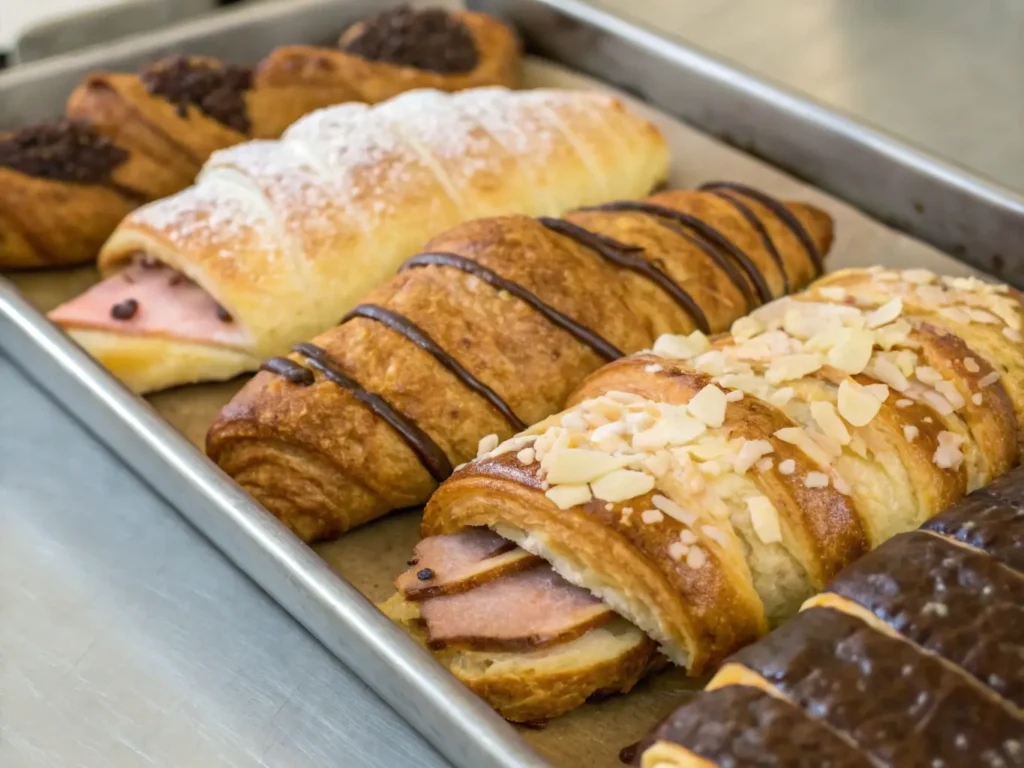What Is a Croissant Loaf?
A croissant loaf is exactly what it sounds like: a combination of a traditional French croissant and a loaf of bread. It has the rich, buttery flavor and flaky, layered texture of a croissant, but is shaped and baked like a loaf, making it easier to slice and serve. Unlike classic croissants that require shaping into crescents, this method skips the rolling into individual pastries and instead layers the dough into a rectangular loaf pan.
This innovation became popular in artisanal bakeries and online trends thanks to its beautiful structure and versatility. The loaf’s interior has visible, airy layers while the crust is golden and crisp. It’s perfect for breakfasts, brunches, or simply served warm with butter and jam.
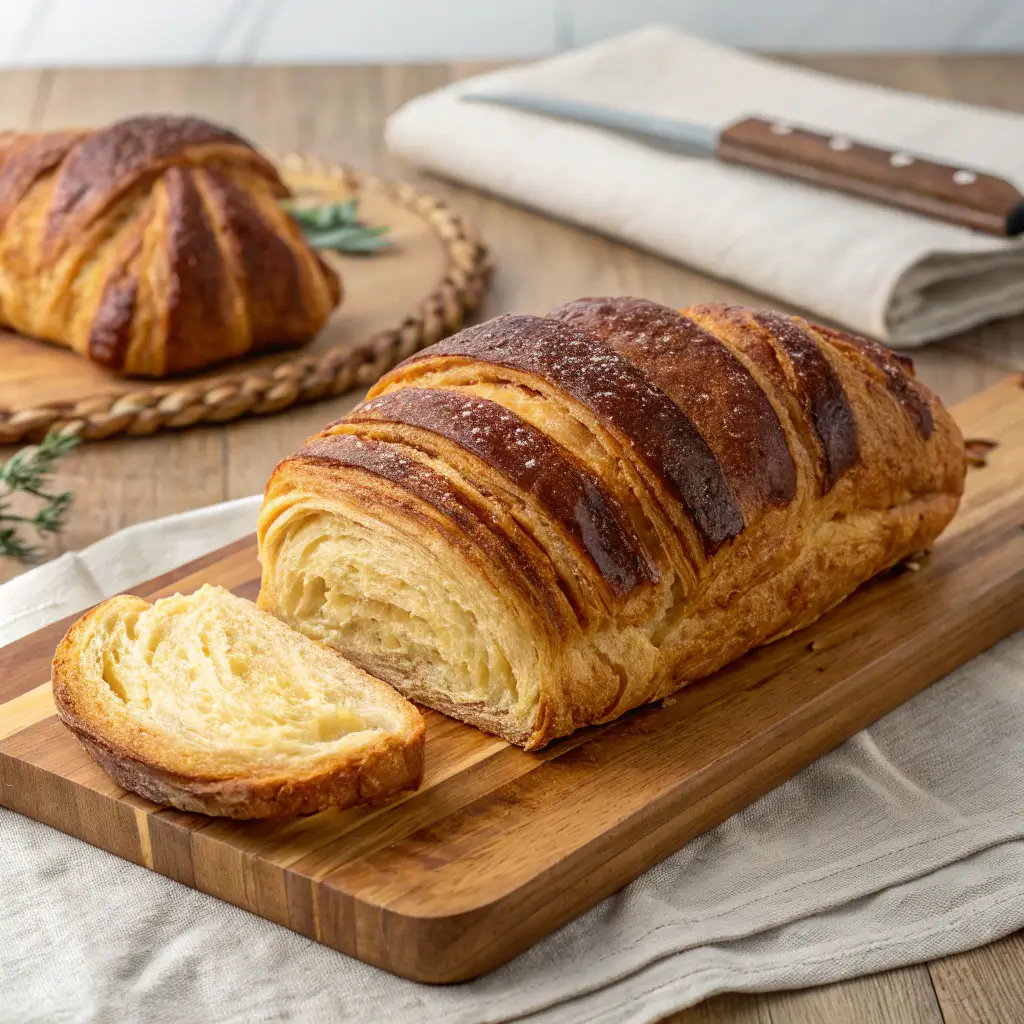
Ingredients You Need for a Croissant Loaf
Creating the perfect croissant loaf starts with choosing the right ingredients. Use high quality butter and flour to ensure the layers are light and crisp. Here’s what you’ll need:
Main Ingredients:
- 3 ½ cups all purpose flour (unbleached)
- 1 cup unsalted butter (European style, cold)
- ¼ cup sugar
- 2 ¼ tsp instant yeast
- 1 tsp salt
- ¾ cup warm milk
- ¼ cup warm water
- 1 egg (for egg wash)
Each ingredient plays a vital role. For instance, European butter has a higher fat content which gives the loaf its signature flavor. The sugar helps the loaf brown beautifully while yeast helps it rise slowly to develop structure.
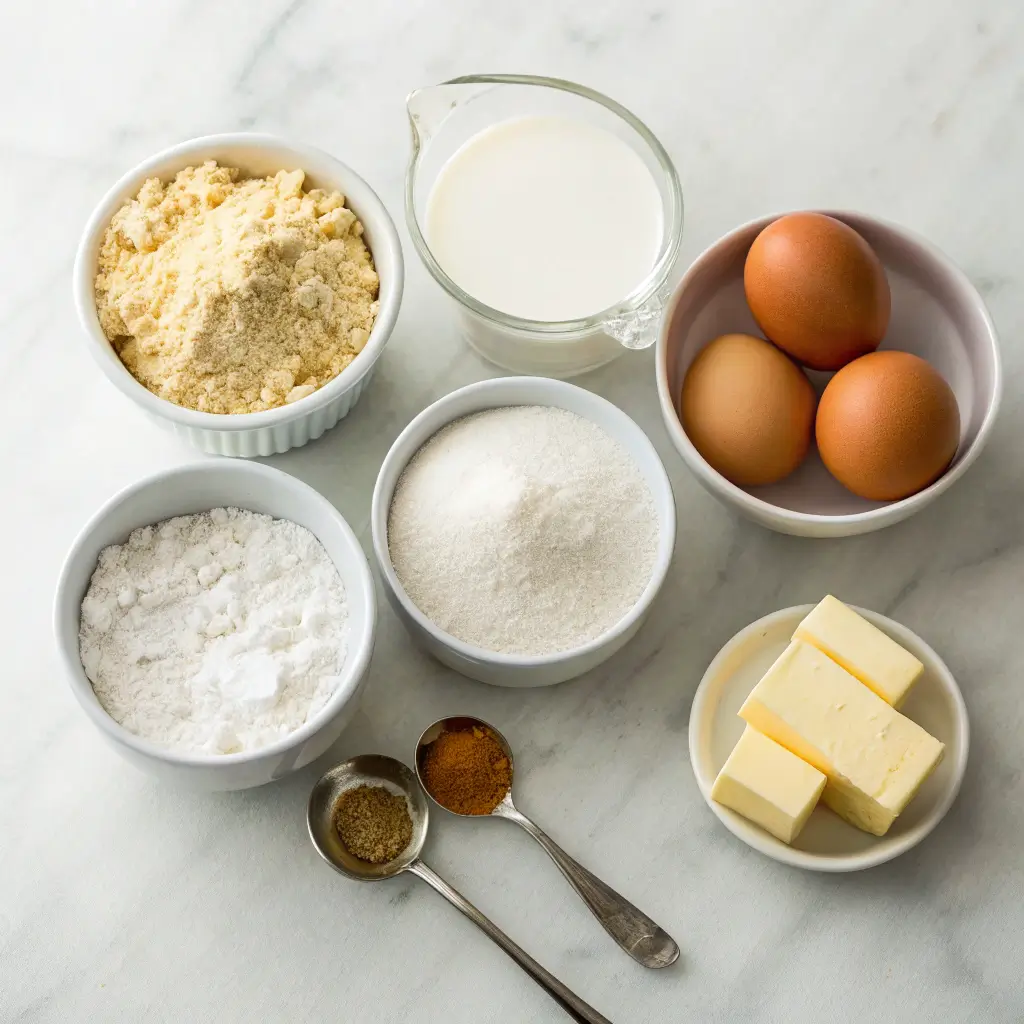
Step by Step Dough Preparation
The heart of a croissant loaf lies in the lamination the process of folding butter into the dough multiple times to create those flaky layers. Here’s how to do it:
1. Make the Dough:
In a mixing bowl, combine warm milk, water, sugar, and yeast. Let it sit for 5 minutes until frothy. Add flour and salt, then knead until a soft dough forms. Cover and refrigerate for at least 1 hour.
2. Prepare the Butter Block:
Place the cold butter between two sheets of parchment paper. Flatten it into a rectangle, roughly 6×8 inches. Chill it until firm but pliable.
3. Laminate the Dough:
Roll out the dough into a 12×18 inch rectangle. Place the butter block in the center and fold the dough over it like a letter. Turn it 90 degrees and roll out again, then fold into thirds. Chill for 30 minutes between each fold, repeating the process 3 times.
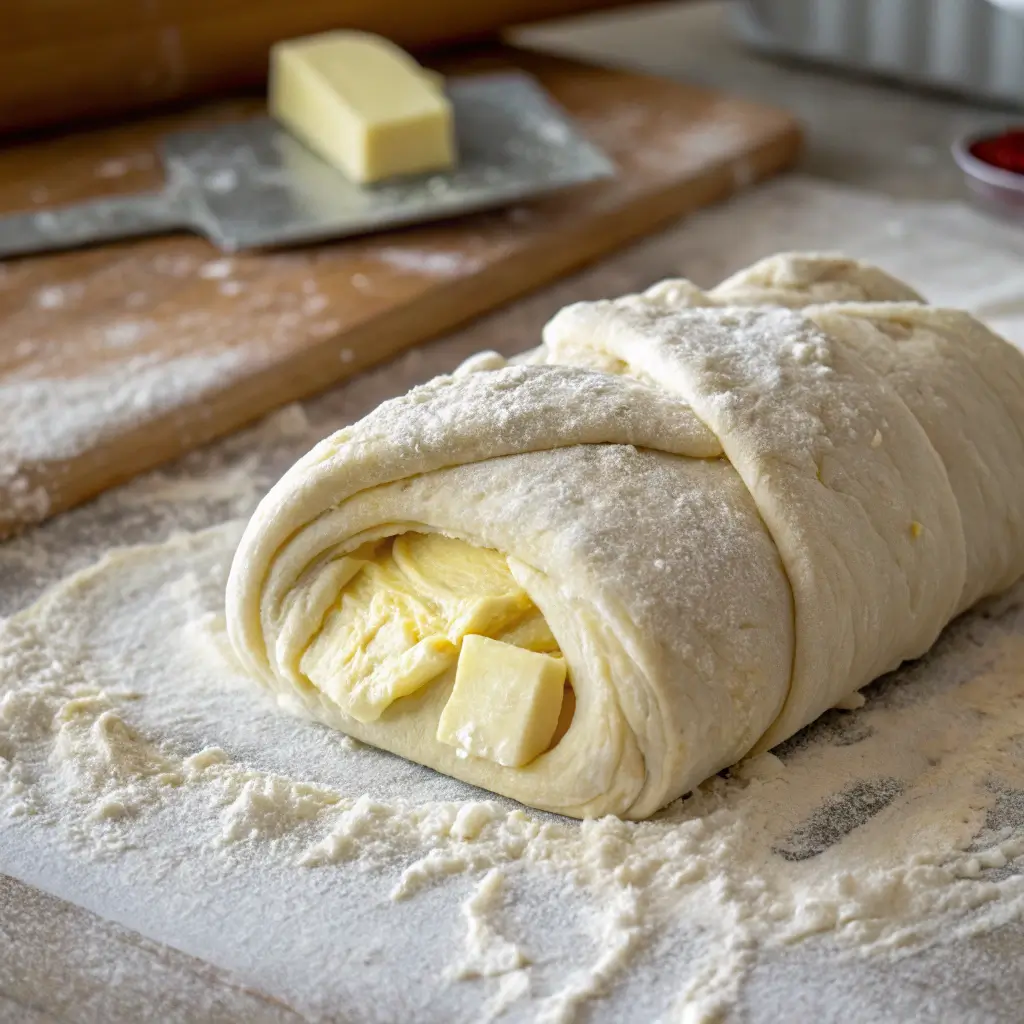
4. Shape and Chill:
After the final fold, roll the dough into a rectangle again, about ½ inch thick. Roll it up tightly like a jelly roll, then place it in a greased loaf pan. Cover and refrigerate overnight or for at least 8 hours.
This long, slow chill gives the dough time to develop flavor and structure.
Proofing and Baking Tips
Once your croissant loaf dough has rested and taken its shape in the pan, it’s time for the final proof and bake. This part is critical rushing it or using the wrong temperature can result in a flat or overly dense loaf.
Final Proof:
After removing the shaped loaf from the fridge, let it sit at room temperature for 1.5 to 2 hours. The dough should puff up and nearly double in size, but avoid overproofing if the loaf gets too airy, the butter may leak during baking and ruin the flaky layers.
Egg Wash for Shine:
Just before baking, gently brush the top of the loaf with a beaten egg mixed with a tablespoon of milk. This gives the finished product that shiny, golden crust croissants are famous for.
Baking Instructions:
Preheat your oven to 375°F (190°C). Bake the loaf on the middle rack for 35 to 40 minutes, or until the crust is deep golden brown and sounds hollow when tapped. If the top starts browning too quickly, loosely cover it with foil during the last 10 minutes.
Let the loaf rest in the pan for 10 minutes, then transfer to a cooling rack for at least 30 minutes before slicing.
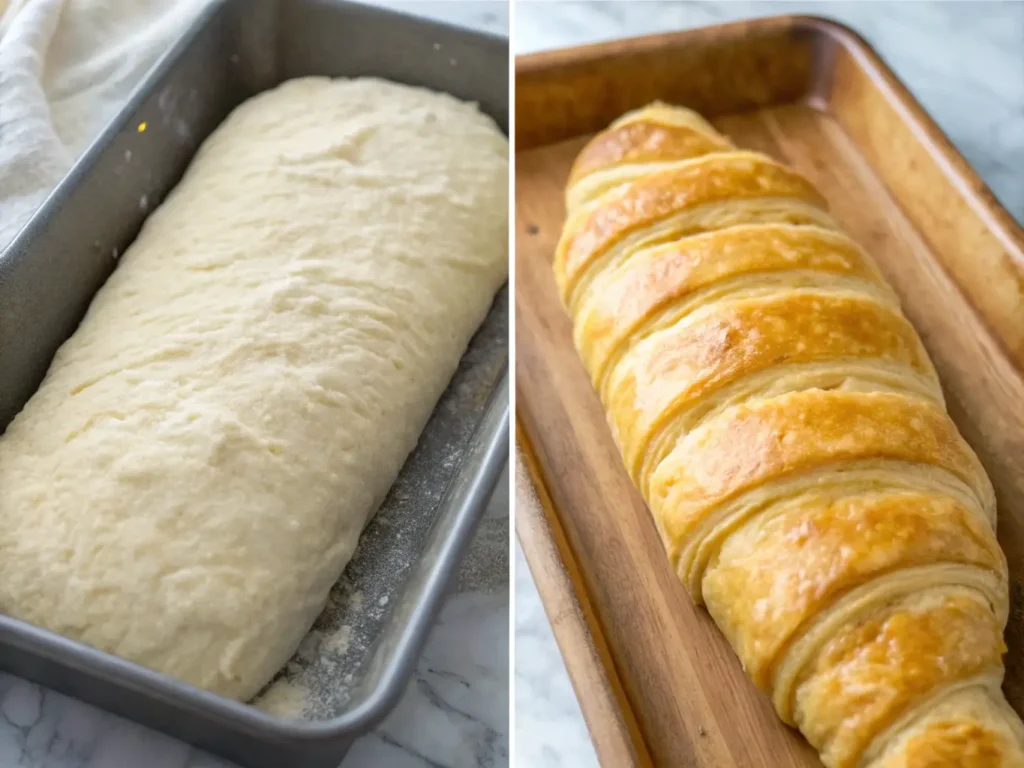
Chef Lucas Benette’s Method for the Flakiest Croissant Loaf
When it comes to refining the croissant loaf, few know the process better than Chef Lucas Benette, who has developed his own tried and true method that emphasizes precision and patience.
Here’s a peek into his approach, as used in his test kitchen:
Lucas Benette’s Tips:
- Chill Between Every Fold:
Lucas recommends chilling the dough for at least 30–40 minutes between each lamination step to ensure the butter doesn’t melt into the dough. This preserves those all important flaky layers. - Butter Quality is Non Negotiable:
He exclusively uses European style butter (at least 82% butterfat). This makes lamination smoother and the flavor richer. - Gentle Touch:
“Don’t overwork the dough,” he warns. Over handling breaks down the butter layers and toughens the final crumb. - Steam Bake for Best Crust:
Lucas uses a cast iron pan with hot water on the bottom oven rack to create steam. This keeps the crust soft during the initial bake, allowing for a higher rise. - Final Chill Before Baking:
After proofing, Lucas chills the loaf for 15 minutes in the fridge before it goes into the oven. This extra step ensures sharper layer definition and a clean, even rise.
His method proves that baking is both a science and an art. With a little patience and some insider knowledge, anyone can achieve bakery level results from their own kitchen.
Common Mistakes to Avoid
Even experienced bakers can face challenges when making a croissant loaf. It’s a delicate pastry that requires attention to detail. Here are some frequent pitfalls and how to sidestep them:
1. Butter Melting During Lamination
Mistake: Rolling out dough while butter is too soft.
Fix: Always chill your dough between folds. If your kitchen is warm, work quickly and use a marble or metal surface to keep the temperature low.
2. Overproofing the Loaf
Mistake: Leaving the dough out too long before baking.
Fix: Once the loaf has nearly doubled in size, it’s ready. If it overproofs, the butter will leak, and the loaf may collapse in the oven.
Serving and Storage Tips
Once your croissant loaf is baked to perfection, the next step is knowing how to serve and store it properly to maintain its flavor and texture.
How to Serve:
Croissant loaf is incredibly versatile. It’s delicious on its own or dressed up with toppings. Here are some ideas:
- Warm with butter and jam
- Sliced and toasted for breakfast
- Used in French toast or bread pudding
- With savory toppings like smoked salmon or ham and cheese

How to Store:
To keep your croissant loaf fresh:
- Room Temperature: Store in an airtight container for up to 2 days.
- Refrigerator: Keeps fresh for up to 5 days, but warm it before serving.
- Freezer: Wrap slices tightly and freeze for up to 1 month. Reheat in the oven or toaster oven for best texture.
Pro Tip: Avoid storing it uncovered or in the fridge without protection. The loaf will dry out quickly due to its low moisture content.
Nutritional Breakdown of a Croissant Loaf Slice
Here’s a quick nutritional snapshot based on a standard slice (about 60g) of plain croissant loaf. Keep in mind that filled versions will vary.
| Nutrient | Per Slice (Approx.) |
|---|---|
| Calories | 280 kcal |
| Total Fat | 16g |
| Saturated Fat | 10g |
| Carbohydrates | 28g |
| Sugars | 4g |
| Protein | 5g |
| Fiber | 1g |
| Cholesterol | 45mg |
| Sodium | 210mg |
Note: For reduced calories, consider using less butter in the lamination and smaller portion sizes.
The croissant loaf is an indulgent treat, but thanks to its richness, a small slice goes a long way in satisfying your cravings.
FAQs About Croissant Loaf and Croissants in General
1. What is a croissant in a bakery?
A croissant is a classic laminated pastry known for its buttery flavor and flaky texture. In bakeries, it’s made by folding butter into dough several times to create thin layers that puff up during baking. Croissants are typically crescent shaped, but the same dough can also be used for pastries like pain au chocolat or even croissant loaves.
2. Does Costco bake croissants?
Yes, Costco bakes their croissants fresh in store. They’re known for being large, fluffy, and affordable, using a version of laminated dough. While they may not be as delicate as French bakery croissants, they’re still a popular option for bulk pastry lovers.
3. What is the French law on croissants?
In France, strict food labeling laws apply to croissants. A true “croissant au beurre” must be made using real butter, not margarine. If a bakery uses margarine or other fats, it must be labeled simply as “croissant.” This law helps maintain high standards and transparency in French baking.
4. Is croissant bakery or pastry?
A croissant is considered a pastry, more specifically a viennoiserie a category of baked goods that includes items made from yeast leavened dough enriched with butter, sugar, and eggs. While it’s commonly sold in bakeries, the term “pastry” is more accurate when describing what it is.
Final Thoughts on Croissant Loaf Mastery
Mastering the croissant loaf might feel like a baking milestone and it is. From the satisfying lamination process to the moment you slice into a golden, flaky loaf, it’s a rewarding experience that gets better with practice.
With expert tips from Chef Lucas Benette, including chilling at every step and choosing the best butter, you’re well equipped to turn your kitchen into a mini boulangerie.
So whether you’re baking for a weekend brunch, testing out chocolate or savory twists, or simply elevating your pastry skills, the croissant loaf is a delicious journey worth taking.
